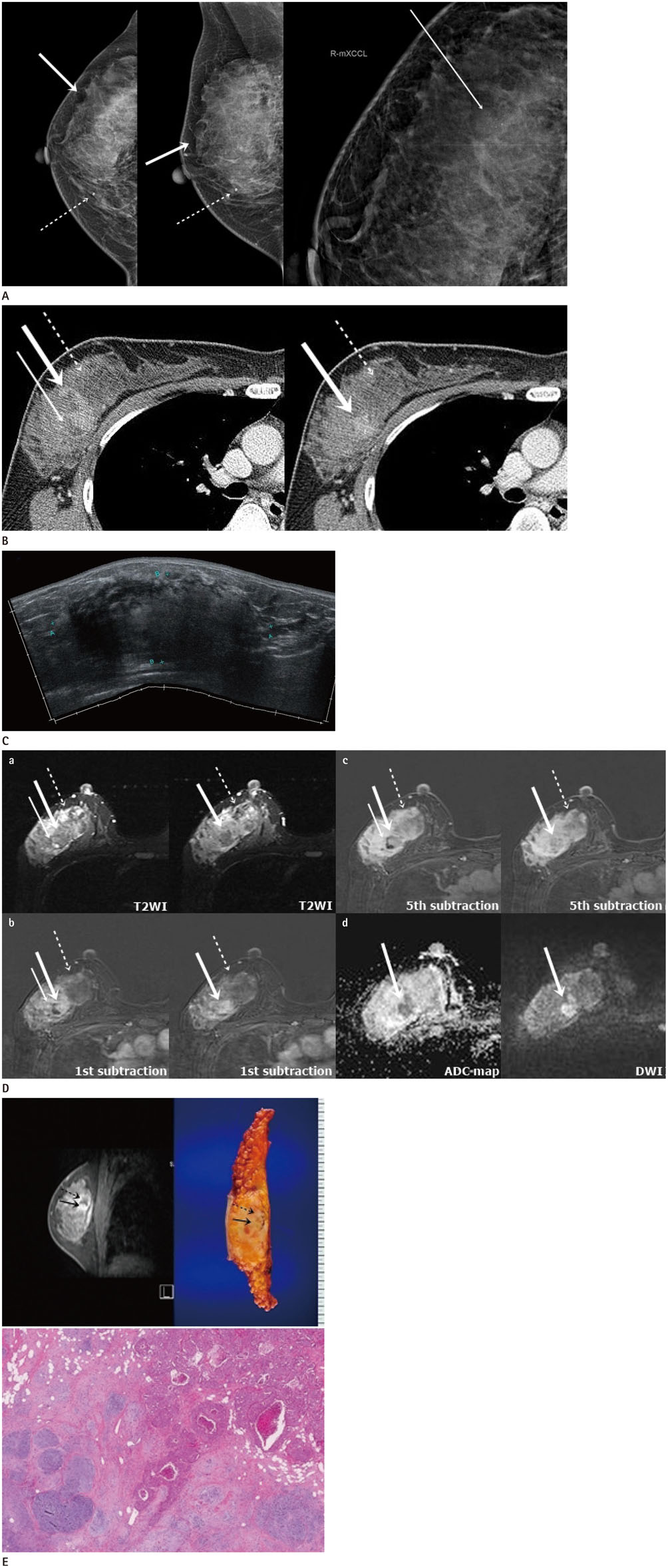J Korean Soc Radiol.
2018 Jul;79(1):27-32. 10.3348/jksr.2018.79.1.27.
Metaplastic Carcinoma with Chondroid Differentiation Mimicking Malignant Phyllodes Tumor: A Case Report
- Affiliations
-
- 1Department of Radiology, Keimyung University School of Medicine, Dongsan Medical Center, Daegu, Korea. shyeo81@dsmc.or.kr
- 2Department of Pathology, Keimyung University School of Medicine, Dongsan Medical Center, Daegu, Korea.
- KMID: 2416402
- DOI: http://doi.org/10.3348/jksr.2018.79.1.27
Abstract
- Metaplastic breast carcinoma is a rare type of neoplasms with mixed epithelial and mesenchymal differentiation. Metaplastic carcinoma with chondroid differentiation is relatively an uncommon type among the different types of metaplastic carcinoma. In this report we present a case of metaplastic breast carcinoma with chondroid differentiation as a complex mass containing both components of invasive ductal carcinoma and chondroid differentiation. The invasive ductal carcinoma and chondroid differentiation show early contrast enhancement, delayed contrast wash out, diffusion restriction and intermediate or high signal intensity on T2-weighted image with minimal contrast enhancement, respectively.
MeSH Terms
Figure
Reference
-
1. Pezzi CM, Patel-Parekh L, Cole K, Franko J, Klimberg VS, Bland K. Characteristics and treatment of metaplastic breast cancer: analysis of 892 cases from the National Cancer Data Base. Ann Surg Oncol. 2007; 14:166–173.
Article2. Fritz A, Percy C, Jack A, Shanmugaratnam K, Sobin L, Parkin DM, et al. International classification of diseases for oncology. 3rd ed. Geneva: World Health Organization;2000. p. 81.3. Grenier J, Soria JC, Mathieu MC, Andre F, Abdelmoula S, Velasco V, et al. Differential immunohistochemical and biological profile of squamous cell carcinoma of the breast. Anticancer Res. 2007; 27:547–555.4. Kim YJ, Shim HS, Lee H, Jung WH. Metaplatic carcinoma with extensive chondroid differentiation in the breast (chondroid carcinoma). Yonsei Med J. 2006; 47:259–263.5. Cheah AL, Billings SD, Rowe JJ. Mesenchymal tumours of the breast and their mimics: a review with approach to diagnosis. Pathology. 2016; 48:406–424.
Article6. Okada N, Hasebe T, Iwasaki M, Tamura N, Akashi-Tanaka S, Hojo T, et al. Metaplastic carcinoma of the breast. Hum Pathol. 2010; 41:960–970.
Article7. Günhan-Bilgen I, Memiş A, Ustün EE, Zekioglu O, Ozdemir N. Metaplastic carcinoma of the breast: clinical, mammographic, and sonographic findings with histopathologic correlation. AJR Am J Roentgenol. 2002; 178:1421–1425.
Article8. Shin HJ, Kim HH, Kim SM, Kim DB, Kim MJ, Gong G, et al. Imaging features of metaplastic carcinoma with chondroid differentiation of the breast. AJR Am J Roentgenol. 2007; 188:691–696.
Article9. Murphey MD, Walker EA, Wilson AJ, Kransdorf MJ, Temple HT, Gannon FH. From the archives of the AFIP: imaging of primary chondrosarcoma: radiologic-pathologiccorrelation. Radiographics. 2003; 23:1245–1278.10. Yang WT, Hennessy B, Broglio K, Mills C, Sneige N, Davis WG, et al. Imaging differences in metaplastic and invasive ductal carcinomas of the breast. AJR Am J Roentgenol. 2007; 189:1288–1293.
Article
- Full Text Links
- Actions
-
Cited
- CITED
-
- Close
- Share
- Similar articles
-
- Metaplastic Carcinoma with Extensive Chondroid Differentiation in the Breast (Chondroid Carcinoma)
- A Case of Malignant Fibrous Histiocytoma-like Sarcomatoid Metaplastic Carcinoma of the Breast
- Metaplastic Carcinoma of the Breast with Chondroid Calcification: A Case Report
- Metaplastic Carcinoma with Chondroid Differentiation Arising in Microglandular Adenosis
- Imaging Findings of Metaplastic Breast Carcinoma with Chondroid Differentiation: A Case Reports


